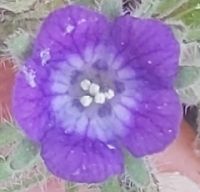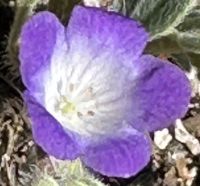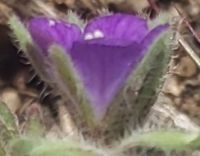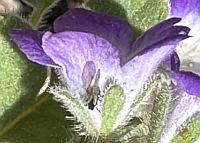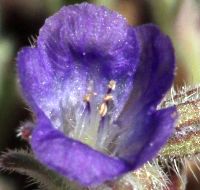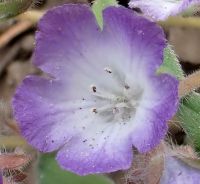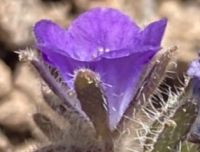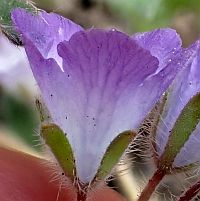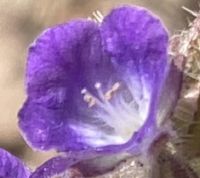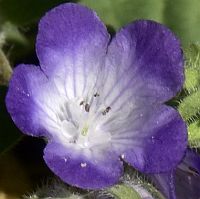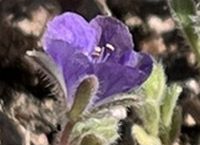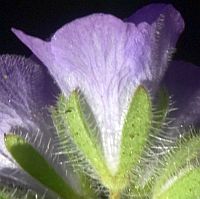Plant Species of San Jacinto Mountain:
Phacelia curvipes, curve-stem phacelia, and P. davidsonii, Davidson's phacelia
Phacelia curvipes, curve-stem phacelia, and P. davidsonii, Davidson's phacelia
Photos of San Jacinto Plants
Introduction
Photos from the Type Localities
Summary of Characteristics That Discriminate These Species
Does P. curvipes Exist in San Diego County?
Photos of San Jacinto Plants
| Phacelia curvipes, curve-stem phacelia | P. davidsonii, Davidson's phacelia |
|---|---|
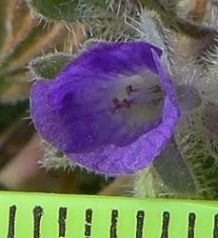
| 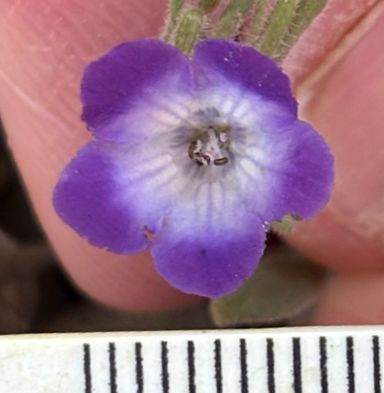
|
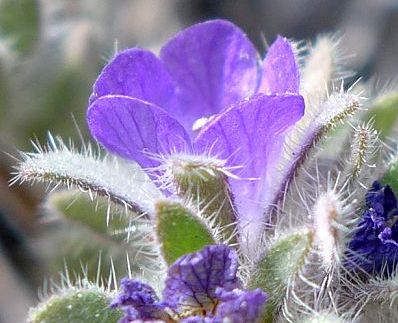
| 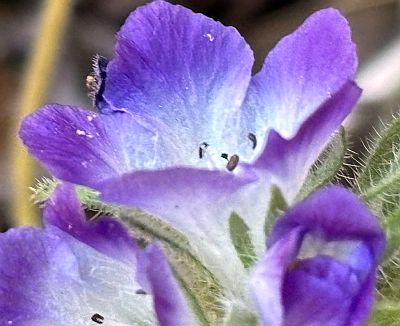
|
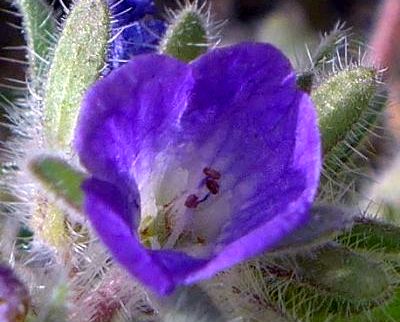
| 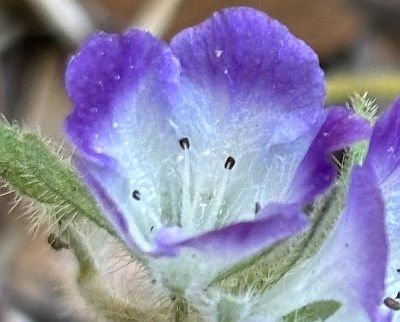
|
| Fig. 1. Photos of Phacelia curvipes (left) and P. davidsonii (right). The photos of P. davidsonii are from Patrick Drew, from the Cedar Spring Trail and PCT south of that trail at San Jacinto Mountain. The photos of P. curvipes are from Tom Chester, only from the PCT near Lion Peak, south of the occurrences of P. davidsonii on the PCT.
The first row shows the flowers at their correct relative size; that of P. curvipes is significantly smaller. The second row shows the flowers from the side. The flower of P. curvipes barely sticks out of its calyx, which has wide calyx lobes. The flower of P. davidsonii much exceeds the calyx lobe tips, and its calyx lobes are narrower. The third row shows a frontal view of the flowers. The blue/purplish part of the flower extends along the entire corolla lobes for P. curvipes, but only is present in the distal half of the corolla lobes for P. davidsonii. The blue/purplish part of the flower is bluer for P. davidsonii. That color difference is obvious in the field, and in most photos. Automatic color-balancing can make the colors appear similar, which is often a problem with blue-purple flowers. Compare the colors of the photograph at bottom right above with the original iNat obs to see the difference. Click on the pictures to go to the original iNat observations. | |
Introduction
Distinguishing P. curvipes from P. davidsonii has caused me, and others, much grief. If their reported number of chromosomes is correct, the two are clearly distinct species that cannot interbreed, since P. curvipes has n=11, and P. davidsonii has n=10. So if you can count the chromosomes, you have a clear determination.
Of course, most of us can't count the chromosomes, so we have to use morphological measurements to separate them. But even experts have difficulty at times distinguishing them! For example, the plants in San Diego County were originally called P. aldersonii, which the first monograph on these species placed with P. curvipes, but the second monograph placed with P. davidsonii! Duplicate vouchers often have different determinations, even though they are samples of the same species in a given spot, a clear sign that it is difficult to determine specimens reliably.
Perhaps most of the confusion in southern California came from the Munz 1974 key:
33. Lvs. mostly entire, or if pinnate, plants tending to be montane; seeds ca. 1 mm long ....P. curvipes33'. Lvs mostly pinnate to pinnatifid ==> P. davidsonii
As a result of this key, plants with entire leaves are usually called P. curvipes, and plants with lobed leaves are always called P. davidsonii.
But the key in the last monograph, Howell 1945, is:
4. Leaves mostly entire; corolla 4-6 mm long; style and branches 2-3 mm long ...P. curvipes4'. Leaves entire or lobed; corolla mostly 7-15 mm long; style and branches 4-7 mm long ....P. davidsonii
Howell's key makes it clear that you really can't use the leaves to determine the specimens reliably.
As just one example of how fraught with problems the leaves are, consider the plants on the Cedar Spring Trail above Garner Valley in San Jacinto Mountain. They are clearly P. davidsonii, with corollas 7 to 11 mm long, yet in some years their leaves are mostly entire; in other years their leaves are mostly pinnately lobed; but small plants are found in nearly every year that have entire leaves.4:51 PM 6/17/2025
That pretty much leaves the corolla length to distinguish them, and most photographs do not have a scale in them.
Fortunately, as mentioned in Fig. 1, there are two discriminants easily visible in many pix that separate the species well. First, the flowers of P. curvipes barely stick out of the calyx, having ratios of 0.9 to 1.3 in my preliminary analysis of iNat photos from its type locality near Lake Tahoe. In contrast, the flowers of P. davidsonii stick way out of the calyx, with preliminary ratios of 1.6 to 2.7 from its type locality in Kern County.
Second, the deepest color of the corolla often extends along the entire corolla lobes for P. curvipes, whereas that deepest color is often present only in the distal 3/4 of the corolla lobes for P. davidsonii. My preliminary analysis of P. curvipes specimens from the Lake Tahoe area give a ratio of the corolla deep color to the lobe length of 0.9 to 1.1. For P. davidsonii specimens from Kern County, my preliminary ratios are 0.7 to 0.9.
Fig. 2 shows examples of flowers of P. curvipes from its type locality, the Lake Tahoe area, and flowers of P. davidsonii from its type locality, Kern County.
Photos from the type localities
Summary of Characteristics That Discriminate These Species
Ratio of Corolla to Calyx. This is the easiest discriminant by far, and makes the determination immediately from a picture with a side view. See the middle row in Fig. 1, and the last two columns in Fig. 2.
From the type localities, the ratio is 0.9 to 1.3 for P. curvipes, and 1.6 to 2.7 for P. davidsonii. See Fig. 3.
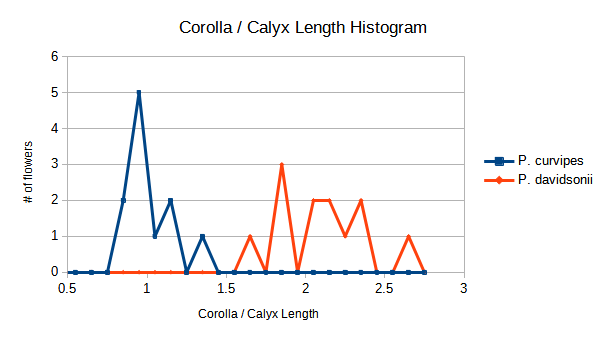
Fig. 3. Ratio of Corolla to Calyx for the plants at the type localities for P. curvipes and P. davidsonii.
Corolla Lengths and Widths. In southern California, for plants of P. davidsonii, I've measured corolla lengths of 5 to 12 mm, and corolla widths of 5 to 15 mm. This is a bit smaller than the "mostly 7 to 15 mm" given in Howell's key, since Howell's range includes areas with larger flowers that have been called P. davidsonii var. grandiflora. My range also includes a measurement of the last flower on one plant, which would be expected to be smaller than normal.
I have almost no experience with P. curvipes, measuring plants at one location with corolla lengths of 5 mm and widths of 4 to 5 mm. This is within Howell's "4 to 6 mm long', and the Jepson manual's "4 to 8 mm long".
It is important to measure the range of corolla sizes on plants in a given location, since there is overlap in the ranges, so that a single small measurement cannot be trusted to give a definitive determination. I typically find corolla lengths up to 9 to 11 mm in areas with P. davidsonii.
Style and Branch Lengths. Howell's key has the style and branches 2 to 3 mm long for P. curvipes, and 4 to 7 mm long for P. davidsonii. The Jepson Manual gave 2 to 4 mm, and 4 to 8 mm, respectively. This is only useful if you have a voucher specimen in hand, since it is very difficult to make measurements accurate to one mm in the field.
Ratio of the length of the corolla deep color at the tip of the corolla, to the length of the corolla lobes. The corolla of P. davidsonii often is obviously deeply colored only at the tips of its corolla lobes, whereas in P. curvipes, the deep color penetrates to the base of the corolla lobes or even farther. The difference is dramatic at times, such as in the middle row of Fig. 1.
However, it is often difficult to see where the base of the corolla lobes are in a picture, and the color sometimes grades from deeply colored at the tip to weakly colored near the base of the lobes, and there are often streaks of color near the base, making it hard to define exactly where the deep color ends.
Furthermore, there is overlap between the species in this characteristic, such that it picks out plants of P. davidsonii better than it picks out plants of P. curvipes.
Nonetheless, this ratio does a pretty good job of separating the species at times, and often is the only characteristic available if there is only a single straight-on photo of the flower. Fig. 4 shows how well the photographs from the type localities of the two species separate.
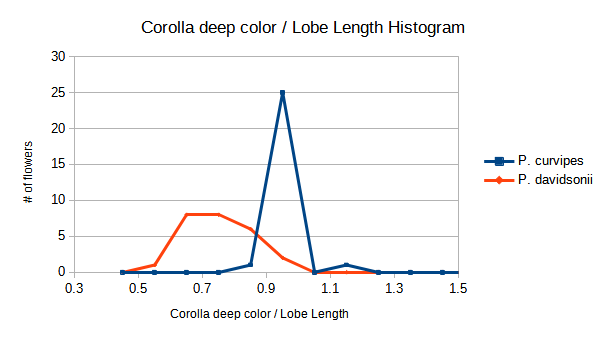
Fig. 4. Ratio of the length of the corolla deep color at the tip of the corolla, to the length of the corolla lobes, for the plants at the type localities for P. curvipes and P. davidsonii.
Presence of pinnate leaves or not. As discussed above, this is more than a bit problematic. If a plant has just entire leaves, this characteristic is useless; both species can have entire leaves.
If a plant has pinnate basal leaves, it is still useless; both plants can have pinnate basal leaves.
If a plant has pinnate cauline leaves, the plant is highly likely to be P. davidsonii.
Does P. curvipes Exist in San Diego County?
Like many others, I thought most of the plants in San Diego County of these two species was P. curvipes. Beauchamp gave P. curvipes as "infrequent", and P. davidsonii as "local".
As of 18 June 2025, there were 36 vouchers of "P. curvipes" from San Diego County, and 38 vouchers of "P. davidsonii". There is no geographical separation for these two species in vouchers, except that there is a higher concentration of P. davidsonii at higher elevations in the Laguna Mountains.
As of 18 June 2025, there were 252 iNat observations called P. curvipes from San Diego County, including 3 observations by me, and 41 observations called P. davidsonii.
Until I started making measurements on the San Diego County plants on 14 May 2025, I was convinced the plants in San Diego County had small corollas, fitting P. curvipes. I suspect I was seeing plants on their last flowers, to give me that impression (see below). Or maybe I just saw their entire leaves, and went with P. curvipes from that.
I was shocked when I first measured the corollas on plants found just above the Big Laguna Meadow, on 14 May 2025, finding corolla lengths of 6 to 11 mm, and corolla widths of 5 to 14 mm. These were essentially the same as the corolla lengths and widths I had measured on plants on the Cedar Springs Trail at San Jacinto Mountain, where I was convinced they were P. davidsonii!
So I went back to the Cedar Springs Trail, and confirmed my previous measurements. I looked through iNat pix from San Diego County, and couldn't find any that looked like P. curvipes. But I did find an interesting comment from Andy Jones on this iNat obs from the Cactus Spring Trail in Riverside County:
I had thought P. curvipes didn't exist south of Pioneertown. I think the plants here at Pinyon Pines match the Carson City plants, based on photos from April 2022 at this location: https://www.inaturalist.org/observations/110894934.https://www.inaturalist.org/observations/107910395
So Andy didn't think P. curvipes existed in San Diego County!
And as far as I can tell, Andy is correct; it doesn't.
P. curvipes is a desert-edge species. The Cactus Spring Trail near Pinyon Pines is eight miles east of the mountain crest of the Santa Rosa / San Jacinto Mountains. We have no comparable locations for P. curvipes / P. davidsonii in San Diego County. There are plenty of similar locations in San Diego County, such as Culp Valley, but so far no one has found either of these two species in such locations.
The best hope for finding it in San Diego County, among locations where these two species had been known to occur, was on the Desert View area of the Lagunas. Alas, all the iNat obs from that area are clearly P. davidsonii. Jim Roberts and I measured the plants near there on 29 May 2025, giving corolla lengths of 5 to 11 mm, and corolla widths of 5 to 12 mm, clearly consistent only with P. davidsonii.
We did find a single depauperate plant, on its last flowers, with a corolla length of 5 to 6 mm. If this is the only specimen that was vouchered, it would be easy to determine it as P. curvipes. But a glance at the flower from the side would deny that determination. I suspect that the San Diego County vouchers cited by Howell as being P. curvipes were similar depauperate plants. One was from "Laguna Mountain", possibly from the Desert View area mentioned above; three were from "Oak Grove to Palomar Mountain", a very unlikely location for P. curvipes, but a very likely location for a depauperate plant.
In addition to the two locations where I have measured the plants, I have also examined 28 iNat obs for the extent of the corolla deep color, finding a ratio of 0.4 to 0.9, in perfect agreement with P. davidsonii I have also examined 19 obs for the ratio of the corolla length to the calyx length, finding a ratio of 1.4 to 3.0, again in perfect agreement with P. davidsonii.
For this examination of the iNat obs from San Diego County, I first went through all the most recent observations, and then examined the most recent observations in each of the areas where there were iNat obs, so I had a good geographic sampling. The majority of the observations don't have pix from the side, or a clear pix showing the base of the corolla lobes, so I made no measurements on them.
I'll continue through the iNat posts of P. curvipes, tagging them now as P. davidsonii, and will continue to look for any that might possibly be P. curvipes.
Btw, "Witch Creek" in San Diego county is the type locality for P. aldersonii, mentioned above as being placed with P. curvipes by the first monographer on these two species, but placed with P. davidsonii by the second monographer (and by all subsequent floras). "Witch Creek" is just west of all the iNat obs of these two species from San Diego County. Greene commented on P. aldersonii:
Low, only 3 to 6 inches high; herbage pale and soft with a fine pubescence, hispid hairness wanting; leaves all simple and entire, acutish, 1 inch long, but the petiole much longer, dilated and as it were winged below the middle; sepals oblanceolate, obtuse, softly hirsute; corollas open-campanulate, twice the length of the calyx.Collected at Witch Creek, San Diego Co., Calif., in 1893, by R.D. Alderson, and distributed for P. davidsonii, from which it is now seen to differ much in foliage, pubescence, calyx, etc.
